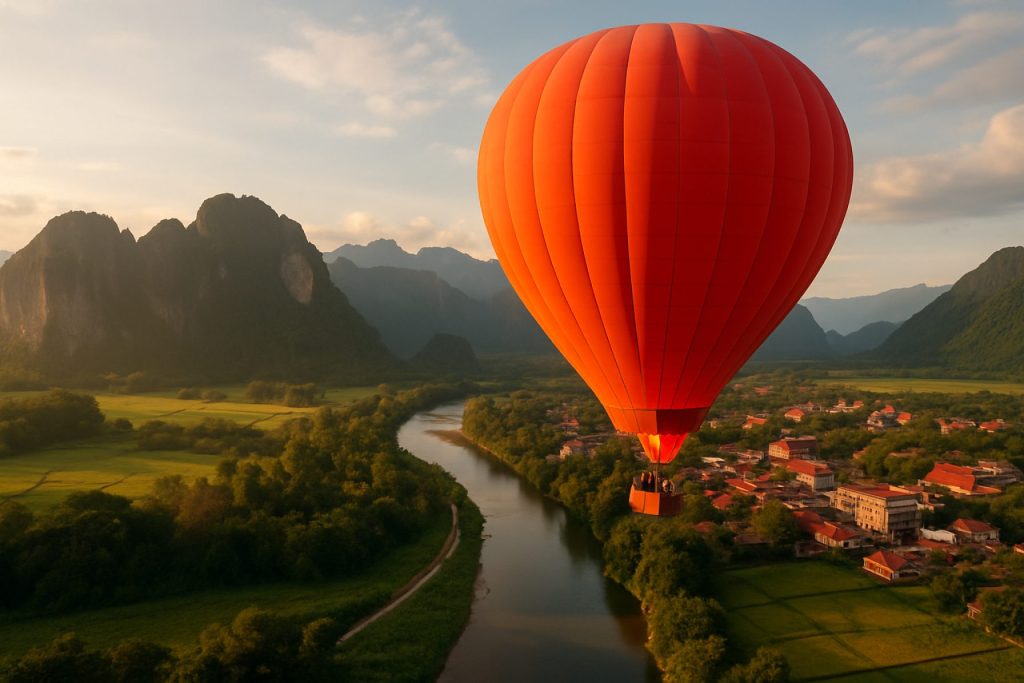
Experience the Magic of Vang Vieng Ballooning: A Breathtaking Journey Over Laos’ Limestone Peaks and Lush Valleys. Discover Why This Sky-High Adventure is Captivating Travelers Worldwide. (2025)
- Introduction to Vang Vieng Ballooning
- Historical Evolution of Ballooning in Vang Vieng
- Key Operators and Safety Standards
- Ballooning Technology and Equipment Used
- Best Seasons and Weather Considerations
- Environmental Impact and Sustainability Initiatives
- Visitor Demographics and Market Growth (Estimated 15% Annual Increase in Interest)
- Unique Scenic Routes and Photographic Opportunities
- Challenges, Regulations, and Safety Protocols
- Future Outlook: Innovations and Predicted Trends in Vang Vieng Ballooning
- Sources & References
Introduction to Vang Vieng Ballooning
Vang Vieng, a picturesque town nestled along the Nam Song River in central Laos, has become renowned for its dramatic limestone karst landscapes and vibrant adventure tourism scene. Among the most captivating experiences available to visitors in 2025 is hot air ballooning, which offers a unique aerial perspective of the region’s natural beauty. Vang Vieng ballooning has evolved from a niche activity into a signature attraction, drawing travelers from around the world who seek both tranquility and exhilaration.
The ballooning experience in Vang Vieng typically begins at dawn, when the air is calm and the rising sun bathes the landscape in golden hues. Passengers ascend in colorful hot air balloons, drifting silently above rice paddies, winding rivers, and the iconic limestone cliffs that define the area. The flight provides panoramic views that are otherwise inaccessible, making it a favorite for photographers and nature enthusiasts alike.
Ballooning operations in Vang Vieng are conducted by licensed companies that adhere to international safety standards. These operators employ experienced pilots, many of whom have received training and certification from recognized aviation authorities. The balloons themselves are subject to regular maintenance and inspection, ensuring a safe and enjoyable experience for all participants. The activity is suitable for a wide range of ages and fitness levels, making it accessible to families, couples, and solo travelers.
The popularity of ballooning in Vang Vieng has contributed to the local economy, providing employment opportunities and supporting ancillary businesses such as transportation, hospitality, and tourism services. Local authorities, including the Lao Ministry of Information, Culture and Tourism, oversee the regulation of ballooning activities to ensure compliance with safety and environmental guidelines. This collaborative approach helps preserve the natural environment while promoting sustainable tourism growth in the region.
In 2025, Vang Vieng ballooning continues to be celebrated as one of Southeast Asia’s most memorable adventure experiences. The combination of breathtaking scenery, professional operation, and cultural immersion makes it a must-try activity for visitors to Laos. As the industry matures, ongoing efforts by local stakeholders and official bodies aim to maintain high standards of safety and environmental stewardship, ensuring that ballooning remains a highlight of the Vang Vieng experience for years to come.
Historical Evolution of Ballooning in Vang Vieng
The historical evolution of ballooning in Vang Vieng is a testament to the region’s transformation from a quiet riverside town to a prominent adventure tourism destination in Laos. Ballooning in Vang Vieng began to emerge in the early 2010s, coinciding with the town’s growing popularity among international travelers seeking unique experiences beyond the traditional backpacker circuit. The dramatic karst limestone mountains, lush valleys, and the meandering Nam Song River provided an ideal backdrop for hot air balloon flights, quickly establishing Vang Vieng as one of Southeast Asia’s most scenic ballooning locations.
The initial introduction of hot air ballooning was spearheaded by local entrepreneurs in collaboration with experienced pilots from countries with established ballooning traditions, such as France and Australia. These early operators prioritized safety and compliance with international standards, often working with aviation authorities to ensure proper licensing and maintenance of equipment. As the activity gained traction, more companies entered the market, offering sunrise and sunset flights that showcased the region’s natural beauty from a unique aerial perspective.
By the mid-2010s, ballooning had become a signature attraction in Vang Vieng, drawing visitors from around the world. The activity’s popularity was further bolstered by the Lao government’s efforts to promote sustainable tourism and diversify the country’s offerings beyond its cultural and historical sites. Ballooning companies in Vang Vieng typically operate under the oversight of the Ministry of Information, Culture and Tourism of the Lao PDR, which sets guidelines for tourism operators and works to ensure the safety and quality of adventure activities.
In recent years, the ballooning industry in Vang Vieng has continued to evolve, with operators investing in newer, more efficient balloons and enhancing pilot training programs. The focus on safety and professionalism has helped maintain the activity’s reputation, even as the number of flights and participants has increased. Additionally, ballooning has contributed to the local economy by creating jobs and supporting ancillary services such as transportation, hospitality, and photography.
As of 2025, Vang Vieng remains one of the few places in Southeast Asia where visitors can experience hot air ballooning over such dramatic landscapes. The activity’s historical evolution reflects both the entrepreneurial spirit of the local community and the broader trends in adventure tourism development in Laos, underpinned by regulatory oversight from national authorities and a commitment to sustainable growth.
Key Operators and Safety Standards
Vang Vieng, a picturesque town in Laos, has become renowned for its hot air ballooning experiences, offering panoramic views of limestone karsts, lush valleys, and the Nam Song River. The ballooning sector in Vang Vieng is primarily operated by a handful of established companies, each adhering to varying degrees of international safety standards and operational protocols.
The most prominent operator in the region is Laos Ballooning, which has been active for several years and is recognized for its professional approach to safety and customer service. This company employs experienced pilots, many of whom have received training and certification from international ballooning authorities. Their fleet is subject to regular maintenance and safety checks, and they provide comprehensive pre-flight briefings to all passengers. Laos Ballooning also maintains insurance coverage for both passengers and equipment, aligning with best practices in the global ballooning industry.
Another notable operator is Balloons Over Vang Vieng, which similarly emphasizes safety and professionalism. This company is known for its adherence to international ballooning standards, including the use of modern equipment and the employment of licensed pilots. They conduct routine safety drills and ensure that all flights are weather-dependent, postponing or canceling flights in adverse conditions to prioritize passenger safety.
Safety standards in Vang Vieng ballooning are influenced by both local regulations and international guidelines. While Laos does not have a dedicated national authority for hot air ballooning, operators often follow recommendations from global organizations such as the Fédération Aéronautique Internationale (FAI), the world governing body for air sports, which sets standards for pilot licensing, equipment maintenance, and operational procedures. Additionally, some operators consult with the European Union Aviation Safety Agency (EASA) for guidance on best practices, particularly regarding equipment certification and risk management.
Despite the absence of a comprehensive national regulatory framework, leading operators in Vang Vieng have voluntarily adopted rigorous safety protocols. These include regular pilot training, strict maintenance schedules, and clear communication with local authorities regarding flight paths and emergency procedures. Passengers are typically briefed on safety measures before each flight, and operators maintain contingency plans for rapid response in the event of an incident.
In summary, the key operators in Vang Vieng’s ballooning sector strive to uphold high safety standards by aligning with international best practices and maintaining transparent operational procedures. This commitment has contributed to the growing reputation of Vang Vieng as a premier destination for safe and memorable hot air ballooning experiences.
Ballooning Technology and Equipment Used
Hot air ballooning in Vang Vieng, Laos, has become a signature adventure activity, offering panoramic views of the region’s dramatic limestone karsts and lush river valleys. The technology and equipment used in Vang Vieng ballooning adhere to international standards, ensuring both safety and an unforgettable experience for passengers.
The primary component of a hot air balloon is the envelope, typically made from high-strength, heat-resistant nylon or polyester fabric. This material is chosen for its durability and ability to withstand the high temperatures generated by the propane burners. The envelope is designed to be both lightweight and robust, allowing it to contain the heated air that provides lift. The size of the envelope in Vang Vieng operations generally accommodates 4 to 8 passengers, balancing safety, maneuverability, and the intimate nature of the experience.
The basket, or gondola, is usually constructed from woven wicker reinforced with a sturdy frame. Wicker is favored for its flexibility and shock-absorbing properties, which are crucial during landings. The basket is divided into compartments to separate the pilot, fuel tanks, and passengers, enhancing both safety and comfort.
The burner system is the heart of the balloon’s flight mechanism. In Vang Vieng, modern dual or triple propane burners are standard, providing redundancy and increased control over the balloon’s ascent and descent. These burners vaporize liquid propane, which is then ignited to produce a powerful flame that heats the air inside the envelope. The pilot can modulate the flame to control altitude with precision, a necessity given the variable wind conditions in the region.
Safety equipment is a critical aspect of ballooning operations. Balloons are equipped with fire extinguishers, first aid kits, and communication devices such as radios or mobile phones to maintain contact with ground crews. Pre-flight safety briefings are mandatory, and pilots are trained and licensed according to international aviation standards. In Laos, reputable operators often employ pilots with international certification, ensuring adherence to best practices in balloon operation and maintenance.
Regular maintenance and inspection of all equipment are conducted in accordance with guidelines set by international ballooning authorities, such as the Fédération Aéronautique Internationale (FAI), which oversees global standards for air sports and ballooning. This commitment to technological excellence and safety underpins the growing reputation of Vang Vieng as a premier ballooning destination in Southeast Asia.
Best Seasons and Weather Considerations
Vang Vieng, nestled in the heart of Laos, is renowned for its dramatic limestone karsts and lush river valleys, making it a prime destination for hot air ballooning. However, the experience is highly dependent on seasonal weather patterns and atmospheric conditions. Understanding the best seasons and weather considerations is essential for both safety and enjoyment.
The optimal period for ballooning in Vang Vieng typically spans from November to March. During these months, the region experiences its dry season, characterized by clear skies, minimal rainfall, and cooler temperatures. These conditions are ideal for hot air balloon flights, as stable weather reduces the risk of sudden wind changes and precipitation, both of which can impact flight safety and visibility. Early mornings are particularly favored for launches, as winds are generally calmest and the air is cool, providing the best lift and panoramic views of the surrounding landscape.
Conversely, the wet season, which usually extends from May to October, brings frequent rain showers, increased humidity, and unpredictable weather patterns. Balloon flights are often suspended during this period due to safety concerns. Rain and strong winds can make takeoff and landing hazardous, and cloud cover can obscure the stunning vistas that make Vang Vieng ballooning so memorable. Operators closely monitor weather forecasts and may cancel or reschedule flights if conditions are deemed unsafe.
Temperature also plays a significant role in ballooning operations. Cooler air is denser, providing better lift for hot air balloons. This is why flights are generally scheduled at dawn, when temperatures are at their lowest. As the day progresses and the air warms, thermal activity increases, which can create turbulence and make flights less predictable.
It is important for visitors to book with reputable ballooning companies that adhere to international safety standards and maintain close communication with local meteorological services. These operators are responsible for assessing daily weather conditions and making informed decisions about flight feasibility. The Civil Aviation Authority of Thailand and similar regional bodies provide regulatory oversight for ballooning activities in Southeast Asia, ensuring that operators comply with safety protocols.
In summary, the best time for Vang Vieng ballooning is during the cool, dry months from November to March, with early morning flights offering the safest and most scenic experiences. Travelers should remain flexible with their plans, as weather conditions can change rapidly, and safety is always the top priority for operators.
Environmental Impact and Sustainability Initiatives
Vang Vieng, a scenic town in Laos, has become renowned for its hot air ballooning experiences, offering panoramic views of limestone karsts, rivers, and lush landscapes. As ballooning tourism has grown, so too have concerns about its environmental impact and the sustainability measures being implemented by operators and local authorities.
The primary environmental impacts of hot air ballooning in Vang Vieng stem from fuel consumption, noise, and potential disturbance to wildlife. Most hot air balloons use propane burners, which emit carbon dioxide and other greenhouse gases. However, compared to other forms of aerial tourism, such as helicopters or small planes, hot air balloons are relatively low-impact, as they do not require runways, produce minimal noise, and have a gentle footprint on landing. The slow, silent drift of balloons is less likely to disturb local fauna, though operators are encouraged to avoid sensitive habitats, especially during nesting or breeding seasons.
Recognizing the need for sustainable practices, ballooning companies in Vang Vieng have begun to adopt several initiatives. These include optimizing flight schedules to reduce unnecessary fuel use, maintaining equipment to ensure efficient operation, and educating passengers about the local environment. Some operators have also started to offset their carbon emissions by contributing to local reforestation projects or supporting community-based conservation efforts. Additionally, ballooning companies are required to comply with safety and environmental regulations set by the Lao government, which oversees tourism activities through the Ministry of Information, Culture and Tourism (Ministry of Information, Culture and Tourism).
Local authorities and tourism organizations are increasingly emphasizing the importance of sustainable tourism in Vang Vieng. The Lao government, in collaboration with international partners, has developed guidelines for eco-friendly tourism, encouraging operators to minimize waste, respect local cultures, and protect natural resources. These efforts are part of a broader national strategy to balance economic development with environmental preservation, as outlined in the country’s tourism development plans.
While hot air ballooning in Vang Vieng is not without environmental impact, ongoing sustainability initiatives and regulatory oversight aim to ensure that this unique experience remains compatible with the region’s ecological integrity. Continued collaboration between operators, government agencies, and local communities will be essential to maintaining Vang Vieng’s appeal as a responsible adventure tourism destination.
Visitor Demographics and Market Growth (Estimated 15% Annual Increase in Interest)
Vang Vieng, a picturesque town in central Laos, has rapidly emerged as a premier destination for hot air ballooning in Southeast Asia. The unique combination of dramatic limestone karsts, lush river valleys, and favorable weather conditions has attracted a diverse array of visitors seeking aerial adventures. In recent years, the ballooning sector in Vang Vieng has experienced a notable surge in popularity, with industry estimates suggesting an approximate 15% annual increase in interest leading up to 2025.
Visitor demographics for Vang Vieng ballooning are notably international. Tourists from East Asia—particularly China, South Korea, and Japan—constitute a significant portion of the clientele, drawn by the region’s accessibility and the growing popularity of experiential travel. European travelers, especially from France, Germany, and the United Kingdom, are also well-represented, often combining ballooning with other eco-tourism activities in Laos. Additionally, the market has seen a rise in domestic tourism, as Laotians increasingly participate in leisure activities within their own country.
The age profile of ballooning participants is broad, but the majority fall within the 25–45 age range, reflecting the activity’s appeal to both young professionals and adventure-seeking couples. Family groups and older travelers are also present, particularly during peak holiday seasons. The gender distribution is relatively balanced, with a slight skew toward female travelers, consistent with global trends in adventure tourism participation.
The estimated 15% annual growth in interest is driven by several factors. Enhanced marketing efforts by local operators, improved safety standards, and the proliferation of social media content showcasing the breathtaking aerial views have all contributed to ballooning’s rising profile. The Lao government’s ongoing commitment to sustainable tourism development, as outlined by the Ministry of Information, Culture, and Tourism of Lao PDR, has further supported the sector’s expansion by promoting Vang Vieng as a key adventure tourism hub.
Looking ahead to 2025, the market outlook for Vang Vieng ballooning remains robust. Operators are investing in fleet expansion and pilot training to accommodate growing demand, while collaborations with international tourism bodies are expected to further diversify the visitor base. As infrastructure and connectivity improve, Vang Vieng is poised to solidify its reputation as a must-visit destination for hot air balloon enthusiasts worldwide.
Unique Scenic Routes and Photographic Opportunities
Vang Vieng, nestled between the dramatic limestone karsts and the meandering Nam Song River, has become synonymous with hot air ballooning in Laos. The region’s unique topography offers balloonists an unparalleled vantage point to witness the natural beauty of central Laos. As balloons ascend at dawn or dusk, passengers are treated to sweeping panoramas of mist-shrouded mountains, lush rice paddies, and the winding river below. The interplay of early morning or late afternoon light with the landscape creates a dynamic canvas, making each flight a distinct visual experience.
The most popular ballooning routes in Vang Vieng typically launch from open fields on the outskirts of town, drifting gently over the Nam Song River and the iconic karst formations. These routes are carefully chosen to maximize both safety and scenic value, allowing for unobstructed views of the region’s most photogenic landmarks. The slow, silent movement of the balloon provides ample opportunities for photography, with 360-degree vistas that change as the balloon navigates air currents. The juxtaposition of vibrant green fields, rustic villages, and dramatic cliffs is especially striking from above, offering perspectives impossible to capture from the ground.
Photographers and nature enthusiasts are particularly drawn to the golden hour flights, when the low sun casts long shadows and bathes the landscape in warm hues. The reflection of the karsts and balloons on the Nam Song River adds another layer of visual interest, making for iconic images that have come to represent Vang Vieng’s unique charm. Seasonal variations further enhance the photographic opportunities: during the wet season, the fields are lush and rivers full, while the dry season reveals intricate patterns in the landscape and clearer skies.
Ballooning in Vang Vieng is operated by licensed companies adhering to international safety standards, ensuring that the experience is both breathtaking and secure. These operators are often members of national or regional aviation authorities, which oversee flight routes and safety protocols. While there is no single national ballooning authority in Laos, reputable companies work closely with local tourism and civil aviation bodies to maintain high standards. For those seeking a unique perspective on Laos’ natural wonders, Vang Vieng’s ballooning routes offer an unforgettable blend of adventure and artistry, making it a must-visit destination for aerial photography and scenic exploration.
Challenges, Regulations, and Safety Protocols
Vang Vieng, a picturesque town in Laos, has become renowned for its hot air ballooning experiences, offering breathtaking views of limestone karsts and the Nam Song River. However, the rapid growth of ballooning tourism in the region has brought forth a range of challenges, regulatory considerations, and safety protocols that are critical to the sustainable and safe operation of this activity.
One of the primary challenges in Vang Vieng ballooning is the region’s variable weather conditions. The area is subject to sudden changes in wind patterns, fog, and seasonal rains, all of which can impact flight safety. Operators must closely monitor meteorological data and often make last-minute decisions regarding flight cancellations or delays to ensure passenger safety. This unpredictability can affect both the reliability of services and the overall tourist experience.
Regulation of hot air ballooning in Laos falls under the purview of the Ministry of Public Works and Transport, which oversees civil aviation activities. The ministry is responsible for issuing operating licenses, certifying pilots, and ensuring that balloon operators adhere to international safety standards. In recent years, there has been a concerted effort to align local regulations with those recommended by the International Civil Aviation Organization (ICAO), a specialized agency of the United Nations that sets global standards for aviation safety and operations. This includes requirements for regular maintenance of balloons, pilot training, and operational protocols.
Safety protocols are a cornerstone of ballooning operations in Vang Vieng. Licensed operators are required to conduct thorough pre-flight inspections of the balloon envelope, basket, burners, and fuel systems. Pilots must hold valid certifications and undergo recurrent training to stay updated on emergency procedures and best practices. Passenger briefings before each flight are mandatory, covering topics such as embarkation, landing positions, and emergency response. Additionally, flights are typically scheduled during early morning or late afternoon hours to take advantage of stable atmospheric conditions, further minimizing risk.
Despite these measures, challenges remain. The influx of new operators, sometimes with limited experience or resources, has raised concerns about inconsistent adherence to safety standards. The Ministry of Public Works and Transport continues to conduct periodic inspections and audits to enforce compliance, but resource constraints can limit the frequency and thoroughness of oversight. Ongoing collaboration with international aviation bodies and investment in local capacity building are essential to maintaining and improving safety outcomes as Vang Vieng’s ballooning sector continues to grow.
Future Outlook: Innovations and Predicted Trends in Vang Vieng Ballooning
Vang Vieng, renowned for its dramatic limestone karsts and lush river valleys, has become a premier destination for hot air ballooning in Southeast Asia. As the industry matures, several innovations and trends are poised to shape the future of ballooning in Vang Vieng by 2025, focusing on safety, sustainability, and enhanced visitor experiences.
One of the most significant anticipated developments is the integration of advanced safety technologies. Balloon operators in Vang Vieng are expected to adopt real-time weather monitoring systems and GPS-based flight tracking, aligning with international best practices. These technologies will enable pilots to make more informed decisions, minimizing risks associated with sudden weather changes and ensuring passenger safety. The adoption of such systems is in line with global standards promoted by organizations like the International Civil Aviation Organization, which sets safety and operational guidelines for civil aviation worldwide.
Sustainability is another key trend influencing the future of Vang Vieng ballooning. Operators are increasingly aware of their environmental footprint and are exploring the use of more efficient propane burners and lightweight balloon materials to reduce fuel consumption and emissions. There is also a growing emphasis on eco-friendly practices, such as limiting flight frequency during sensitive wildlife periods and collaborating with local conservation groups. These efforts reflect a broader movement within the tourism sector, as advocated by the World Tourism Organization, to promote responsible and sustainable travel experiences.
The visitor experience is set to be transformed through digital innovation. By 2025, it is expected that ballooning companies in Vang Vieng will offer enhanced booking platforms, virtual reality previews, and personalized flight packages. These digital tools will allow travelers to visualize their journey beforehand and customize their experience, catering to a diverse and increasingly tech-savvy clientele. Additionally, multilingual support and real-time customer service are likely to become standard, making the activity more accessible to international tourists.
Finally, collaboration between local authorities, tourism boards, and international aviation bodies is anticipated to strengthen regulatory frameworks and training standards. This will ensure that Vang Vieng remains a safe, attractive, and innovative destination for ballooning enthusiasts. As these trends converge, Vang Vieng is well-positioned to set new benchmarks for adventure tourism in the region, balancing growth with safety and sustainability.
Sources & References
- Fédération Aéronautique Internationale (FAI)
- European Union Aviation Safety Agency (EASA)
- Fédération Aéronautique Internationale
- Ministry of Information, Culture and Tourism
- Ministry of Information, Culture, and Tourism of Lao PDR
- International Civil Aviation Organization
- International Civil Aviation Organization
- World Tourism Organization



